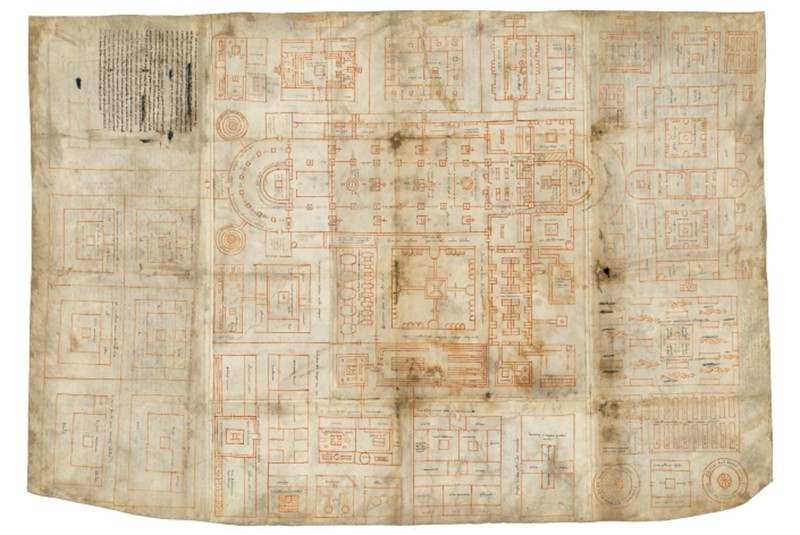
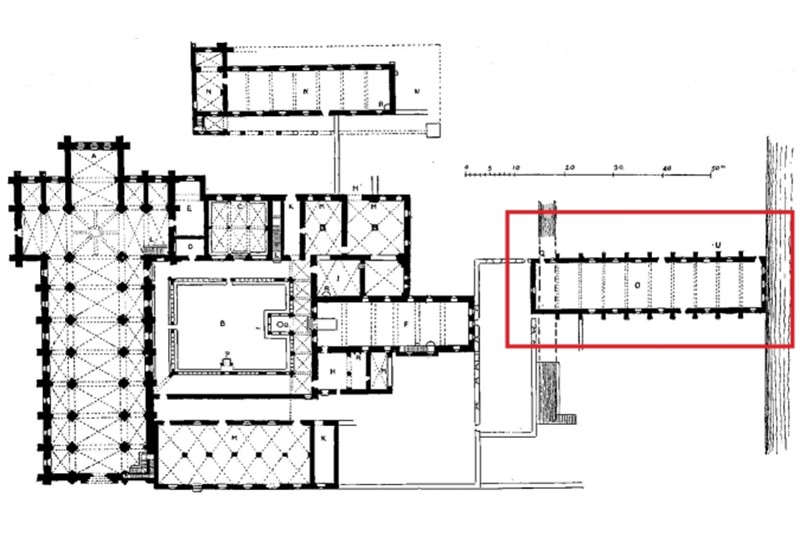
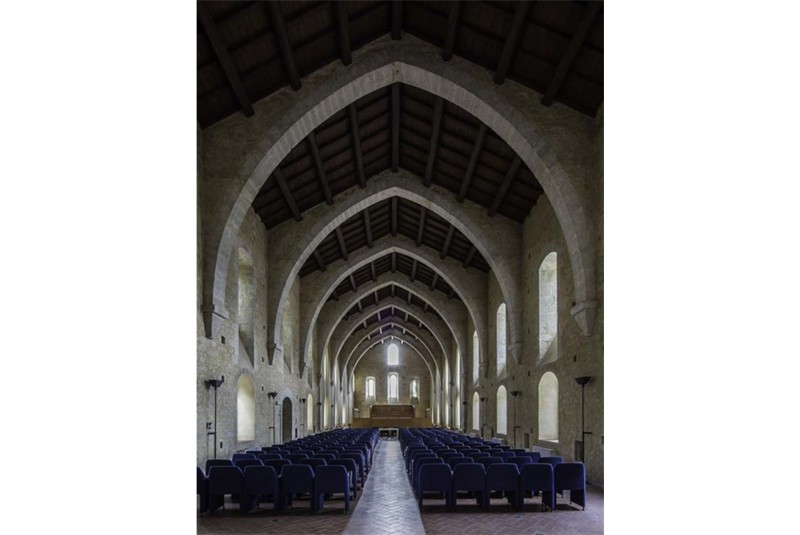
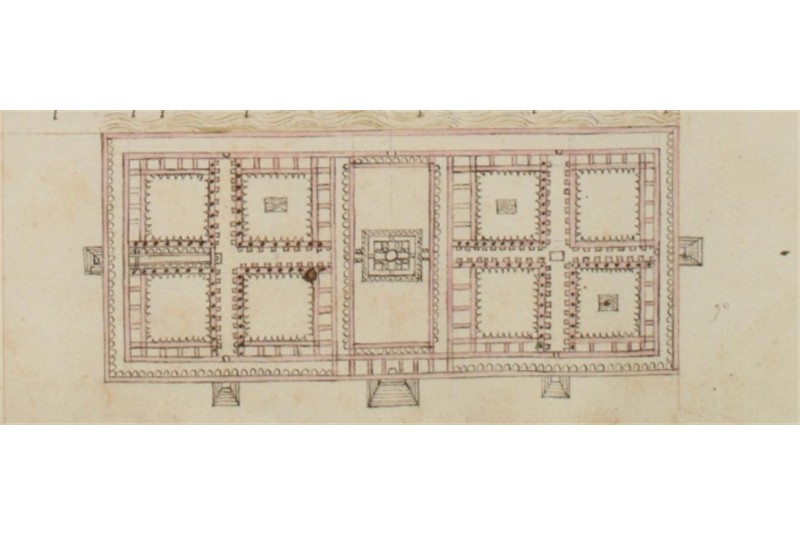
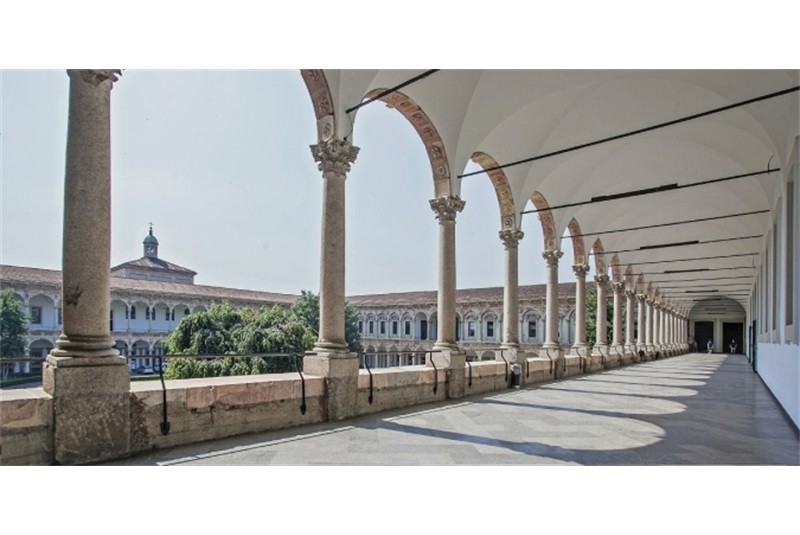
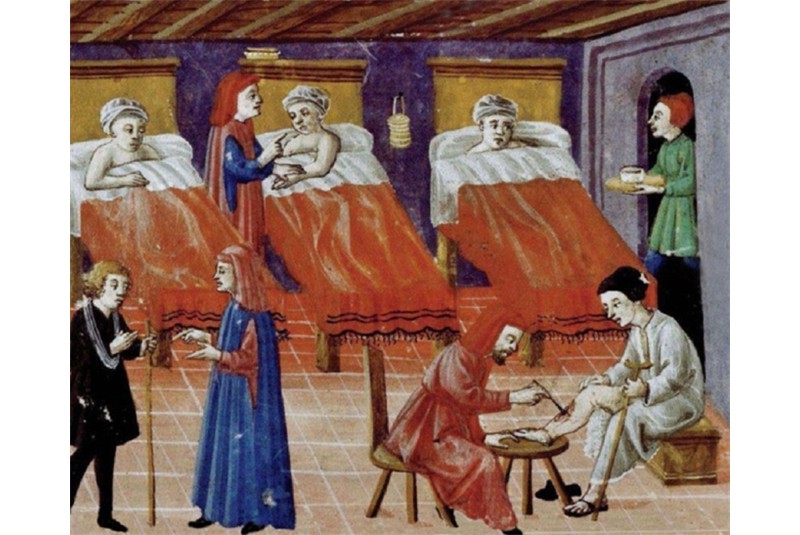
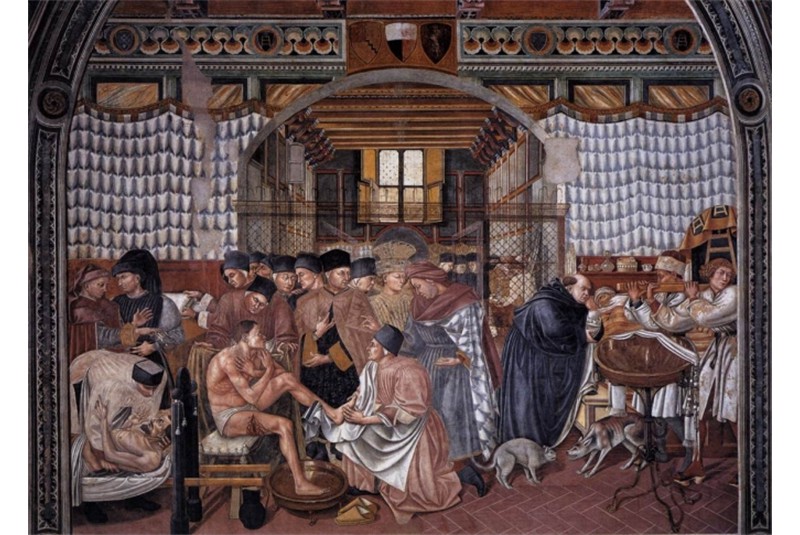
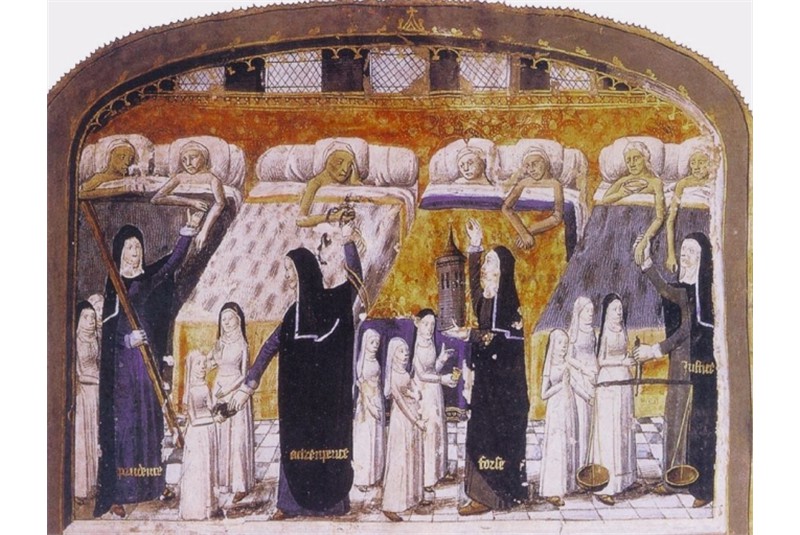
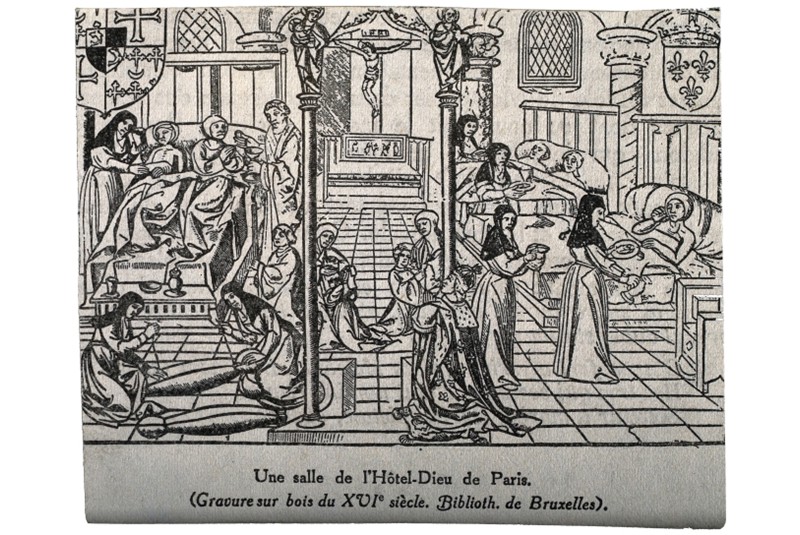
When we consider the genesis
of organized welfare structures we have necessarily to start with the
hospital founded by Basil, future holy bishop of the city of Caesarea,
now Kayseri in Cappadocia, Turkey. Built extra moenia with an adjoining
church and monastery, it came into being around 370 in close relation
to the Basilian monastic conception, which flowed into a rule that
predated the Benedictine one by about two centuries; this rule was
aimed at the spiritual and physical care of the person as one of the
most edifying Christian acts. The idea of creating places intended for
care cannot be separated from the idea of the good Christian who must
care for the soul and at the same time fot its container, according to
that doctrinaire reference to Christus
medicus that, from a hagiographic point of view, will find
fulfillment in the “medical saints” Cosmas and Damian. In
pre-Christian antiquity there were, of course, places for the care of
the needy, but it was mostly run by families with rare cases of partial
communal management of slaves or wounded soldiers returning from
endless military campaigns.
What jumps out at us regarding the first organized experiences that we
label for convenience “charitable” in the centuries of late
antiquity and throughout the early Middle Ages is the, we would say
today, polyvalent character of the services offered. The earliest
xenodochia, whose etymology, not surprisingly, refers simply to a kind
of “refuge for strangers,” in the evidently all-Christian
sense of unselfish welcoming to all, offered help to various types of
“needy” people: certainly the sick, but also the poor,
those with ambulation problems, the elderly, orphans, beggars and, of
course, with great fortune in later centuries, pilgrims. It is
necessary, however, to wait until the end of the 8th century, with
Alcuin bishop of York, to be certain of the substantial coincidence
between xenodochia, hospices and hospitals, suggesting a linguistic
division that was not easily found in the factual context. For these
centuries, and basically until the High Middle Ages, we are not able to
identify architectural specificities, except by resorting to purely
monastic models, with the caution, however, that the planimetric
typology of the monastery consisting of a church, cloister on one side
and adjoining spaces around it is a model that is substantially
established in the late Carolingian period, leaving a textual and
archaeological gap that is difficult to recompose for the previous half
millennium. Since Pre-Carolingian monasteries were admittedly
fenced-off places, tending to be isolated, although mostly visible,
away from or on the periphery of towns, in which monks lived in
separate spaces with the exception of the church, we must imagine that
the structures that housed monks were the same as those that housed the
needy. This at least seems to be suggested by the celebrated plan of
St. Gallen (Fig. 1), from the first quarter of the ninth century, a
plan that is more ideal than real, but nonetheless useful for reasoning
about the spaces of a Carolingian monastic complex and thus of all
Europe ruled by Charlemagne. The infirmary, houses for traveling monks,
important guests, pilgrims and the poor are shown, as well as the
bathhouse, kitchen, medicinal plants, doctors’ quarters even the
salassium room.
In the literature, the two fundamental step changes are that identified
between the the end of twelfth and the thirteenth century and that of
the fifteenth century, actually as a long wave of the Black Death of
the mid-fourteenth century. In the first case there is an exponential
increase in foundations for assistance in Europe, an increase dictated
by new general conditions (the so-called Revival of the 12th century),
conjunctural ones (the increase in the number of pilgrims with the
Crusades), and political ones, in reference to a greater number of
actors at play. No longer are there only the Benedictines, their
Cluniac “spin-off”, and the bishops to carry the burden,
but now we can also encounter new orders such as the Cistercians, the
Premonstratensians, monastic-chivalric orders such as, precisely, the
Hospitallers of St. John, and finally, in the decades at the turn of
the 1200s, the Humiliati and then the beghine movement, and immediately
afterwards the mendicant conventual orders, Franciscans and Dominicans.
Among the actors in play, in the 12th century the laity also entered
powerfully, both in the communal and proto-state forms of the great
European powers, but also in new forms of Christian evergetism by which
the setting up of a welfare structure no longer had anything to do with
the Christian spirit and became mostly only a public manifestation of
power, resulting in the rise of a new secular sanctity between the late
12th and 13th centuries, a phenomenon on which André Vauchez has
written seminal pages. However, the 12th century is also unanimously
considered the temporal range of the rediscovery of the centrality of
the city. The effects are immediate: cities become wealthier, the
greater the attraction of population, hence greater problems of care
management, consequence: exponential increase in the number of hospital
facilities. It is no coincidence that the Salerno Medical School
reached the height of prestige in the 12th century, and by the first
decades of the 13th century physicians wanted by the municipality
appeared for “collective” care.
However, this does not mean that hospital facilities became
“medical clinics.” The earliest Benedictine survivals in
relation to infirmaries or spaces for care in general date from the
12th/13th centuries, but it is evident, as in the case of Canterbury,
Ourscamps or in Fossanova itself (Figs. 2-3), the dependence on church
and monastic planivolumetric models in general. It is precisely in
these phases, however, with the renewed and intense involvement of the
laity, that the typology of the hall hospital begins to gain strength,
which Fabio Gabbrielli (2020) specifies has nothing to do with the
various Hallenkirchen models and rather we need to think of
quadrangular spaces, whether or not divided into two or three naves,
covered variously with exposed trusses or vaults, and very
longitudinally developed with the only addition of a chapel inserted in
the perimeter itself or in the immediate vicinity.
It’s now accepted fact that there is a connection between the
great health crisis caused by the plague epidemic of about the middle
of the fourteenth century and the great second change of pace, that of
the late fourteenth/early fifteenth century, with the emergence of new
mammoth structures (hence the various “Ospedale Grande” or
“Maggiore”) that saw the fixed presence of physicians (or
apothecaries), gradually abandoning the multipurpose as well as
polycentric character of care facilities that had characterized the
reception system in the previous thousand years. This is
counterbalanced, as is well known, by a different architectural model,
the so-called cross-shaped layout (Fig. 4), a layout on which many
scholars have focused in recent decades in order to understand
primarily its origin-from Pavia, from Milan (Fig. 5), from Brescia,
from Florence...-and, above all, its design intention. In general, the
plague had taught that the dispersion of care spaces had not optimized
the response to the pandemic. Having myriad locations scattered
throughout the territory had proven ineffective, no matter how
strategically located or along obligatory thoroughfares. The response
was therefore a concentration of welfare facilities, now less
multifunctional, certainly more specialized, and tending to be linked
to a secular power no longer the almost exclusive preserve of the
Church or religious orders (Figs. 6-7). However, it is clear today that
the “Great Hospitals” model had not been applied
uncritically; on the contrary, where it was understood that the
specific conditions of a city or territory led to the strengthening of
the old model of widespread welfare architecture there was a tendency
to optimize the coexistence of new and old systems.
Tapping into architectural history as a catalog of solutions on which
to set new design systems, as is well known and, I might add, obvious,
is a very delicate operation. It becomes an almost foolish operation to
assume for other contexts the “geometry” of an
architectural complex designed for a specific space and time, with as
many specific needs and purposes: the risk of the “Las Vegas
effect” is just around the corner. These obvious considerations
become perhaps more pregnant if we think of architectures dedicated to
care in a broader sense; I find it more intriguing, if anything, to
question the reasons for the choices that from time to time determined
individual projects, to investigate the religious and
“political” actors at play, to study spatial innovations
under equal environmental conditions, to collate different projects. A
PRIN entitled At the Origins of
Welfare (13th-16th Centuries). Medieval and modern roots of the
European culture of assistance and forms of social protection and
solidarity credit. was dedicated in 2015 as general reflection,
including architectural reflection, on these issues. Well, although
studies on the medieval and early-modern welfare system were not
lacking for the Middle Ages as much from a historical point of view as
from an architectural history point of view, a general (and global)
reconsideration of the issue has contributed in the very last few years
to the publication in Italy and elsewhere of miscellaneous volumes
that, if on the one hand, offer broad reconstructive scenarios of the
origin of welfare systems (Bianchi 2020, also for its impressive
bibliographical apparatus, has become a reference text to be
complemented by the very recent Barceló Prats 2023), on the
other hand, through specific case-studies (e.g., Siena, on which
Gabbrielli 2023 most recently reports), a perhaps too ideological
conception of the problem of medieval and modern care practices has
been partly reshaped in favor of a more specific analysis of contexts.
And one of the outcomes that such specific research has strongly
suggested is that at some point at the end of the Middle Ages, there
emerged enterprises, we would say today, mutatis mutandis,
“private state-sharing” designed for public welfare (Figs.
8-9). These were structures certainly connected to ideals of propaganda
and self-promotion of the ruling classes, but at the same time, without
going so far as to arrive at an overly idealized image of welfare
between the medieval and modern ages, connected to the revolutionary
idea for those times that the greater the number of people in a given
territory who could have decent standards of care, the greater the
wealth and general welfare.
This aspect certainly deserves all the attention because it projects
the care issue, already in the Middle Ages, in a dimension that goes
beyond the architectural, anthropological, social or banally health
issue. The discussion of possible medieval and modern models or
antimodels, in order to have useful repercussions on the most recent
design solutions tending toward integrated systems of care starting
from an urban scale, should focus on the problem not so much and not
only of efficiency, which is certainly an inescapable aspect, but also
on the question of the real impact on the daily well-being of a
community. It seems to me that this is the real bottom line: no
architectural model in almost two thousand years has solved the issue,
but multiple models adapted to individual territorial contexts has led
to increasingly satisfactory outcomes. While it is clear that Community Health Places and Centers
recall, at least on paper, the earliest late medieval and early
medieval multifunctional hospitals, they depart from them in their
polycentric character, based on spatial distribution in a given
territory, which could invariably have been lowland, sea, road, coastal
or river town or valley territory. In contrast, the “spatial
thickening” of the late medieval and modern Ospedali Grandi, the model of which
is sometimes still applied, concentrated care on the urban level, but
the extreme medical specialization caused all other equally necessary
services to the person to be lost sight of, diluting them into rivulets
with little or poor communication between them.
Bibliography
ALBINI G. (2017) – “Pauperes recreare: accoglienza e aiuto ai poveri nelle comunità monastiche (secoli VI-XI)”. Hortus Artium Medievalium, 23, 490-499.